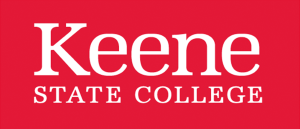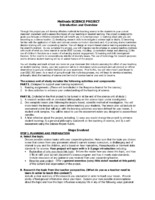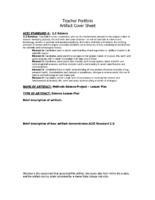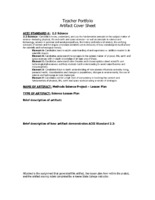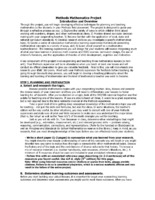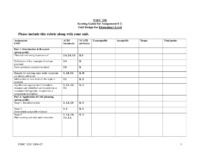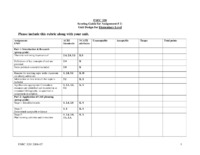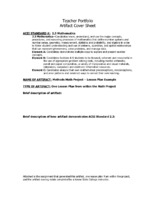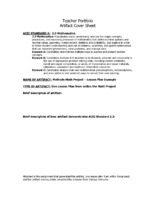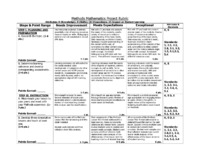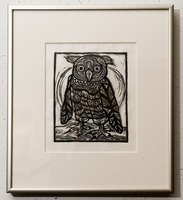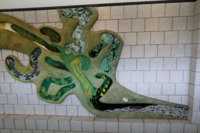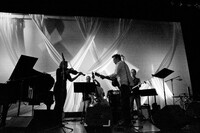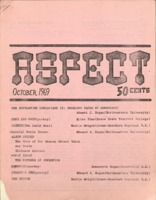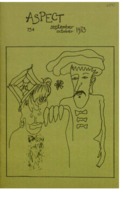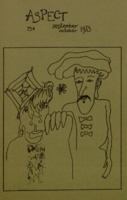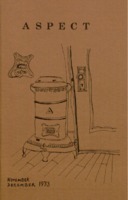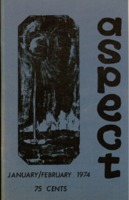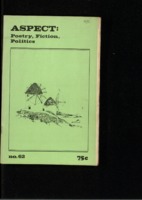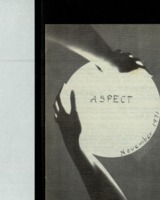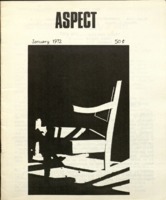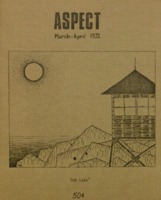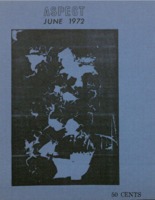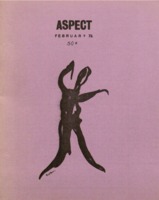Search
13391 items
-
Ashley Bryan's Owl (232)
White background, black ink owl -
Ashore at Panama
Shelf location: K.2 -
Ashuelot River (Answer Print)
2010.787 -
Ashuelot River Flow (823)
3 Dimensional sculpture on the wall, depicting the curves of the Ashuelot River. -
Aspect Magazine vol. 1, issue 4, June 1969
The cover of this issue of Aspect magazine is light blue with Aspect written in a block letter font. The cover page of this typed and stapled issue of the journal includes the table of contents for the eleven-page magazine.The issue begins with an editorial by Edward J. Hogan, = "Violence: The Necessary Tool" and is followed with three poems: "For Elize," by John Manifold, "The Crowd," by Noelle Wright, and "Limerick," by Edward J. Hogan. "Desire Under the Elms: An Unconscious Autobiography" is a summary and review by Mary Harrington of Eugene O'Neill's 1924 play. The summary is taken from the esay by Matthew T. Conlin, "The Tragic Effect of Autumn Fire and Desire Under the Elms" published in Modern Drama (February 1959).There are three additional poems : "Almost There" by Noelle Wright, "A Tree Did Grow" by Alice Nims, and "The Pope Cried, No" by Steve Kellogg , and "Seasons" by Noelle Wright.The issue includes the sixth part of Edward J. Hogan's "History Series" under the title "Edward Burke and English conservatism." On the final page there is a poem by Edward J. Hogan, "The Terrible Two," inspired by "Cream's song 'pressed Rat and Warthog' and a real-life 'terrible (ho, ho) two" as explained in a parenthetical headnote to the poem. The issue concludes with a "P.S." from the editor that reads "My Mistake! I neglected to finish the footnotes for Mary Harrington's drama article. They follow here:" -
Aspect Magazine vol. 10, issue 52, September-October 1973
The front cover of the September-October 1973 issue of Aspect magazine has a green background with a drawing of a well-dressed man and woman, drawn in stencil, surrounded by a border. The artwork is modern and contemporary. The table of contents includes a list of authors of short stories, poems, and artwork. A summary of Aspect magazine and its purpose is at the bottom, and continues onto the back cover with the credo; "If you have done it, and you like it, send it to ASPECT." Aspect welcomes articles, short stories, poetry, review, drama, cartoon, humor, photographs, and letters.The next set of pages is a sequence of short poems "Paradise" by Eric Felderman, an untitled, three-line poem by Arthur Winfield Knight, "From My 7th Floor Window Of The Mental Ward" and "The Carefree" by Fritz Hamilton, "Disturbed Professor Takes Pound Not Pills" by James Klein, and a poem in landscape format called "Uncle's Retirement" by Jane Creighton.The next section is a short story titled "The Machine Shop" by Ottone Riccio with illustrations (one of a woman angel playing a hand saw in place of a violin) and more short poems such as "the present" and "momma: but grace with grace" by R.D. Swets and another short story about Watergate and Vietnam. After the second short story there is another contemporary stencil drawing depicting three human figures and cat.Proceeding this is a final collection of abstract poems. The magazine ends with a commentary by the editor Edward J. Hogan on the contributors to the issue, a poem by Charles Bukowski, and notes about the publishing committee and "The People Inside"describing the authors -
Aspect Magazine vol. 10, issue 52, September-October, 1973
This issue includes art work, a combination of prose and verse poetry, a short story and a political essay. It was put together by co-editors Edward J. Hogan, Ellen Schwartz and Gail Braatelien. The opening contents page lists the artists by page number and some information about the issue and magazine itself. The art in this issue ranges from political commentary to more experimental artwork, poetry and prose writing. There are three pieces of art; two by Ingeborg Hayward, including the magazine's cover photo, and one by Jean Segaloff. They are all untitled. There are poems by Eric Felderman, Arthur Winfield Knight, Fritz Hamilton, James Klein, Jane Creighton, R.D. Swets, Carla Bacon, L.S. Fallis, Judy Neeld, Robert Pinsley, Emilie Glen, Linda Ann Chomin, Barbara Unger, Brett K. Canfield, William Talen, Elliot Fried, Howard Curtis and Ed Porter. There is a short story, "The Machine Shop," by Ottone Riccio, and a short political essay, "Watergate: The Roots of Corruption Lie in Vietnam," by William Blum. Near the end of the magazine, as the last artistic piece, there is a short poem by Charles Bukowski, "When Hugo Wolf Went Mad--."On the back cover of the issue, there is a section called "The People Inside," with brief biographical information on the contributors. The magazine concludes with an encouragement to artists and writers to send work in for later issues. -
Aspect Magazine vol. 10, issue 53, November-December, 1973
This issue begins with an ochre soft-cover illustration by Jean Segaloff and is edited by Edward J. Hogan, Gail Braatelien, Pat Hollopeter, and Ellen Schwartz. The issue is held together by two staples on the spine. On the inside front cover, a table of contents lists the poets, the writers, the artists, the editors, and other miscellaneous information.Poets in this issue include Susan Strayer Deal, Eric Cashen, Joan Colby, Richard Latta, r.d. swets, Robert Pinsley, Margaret Rabb, Robin Becker, Judy Neeld, Christine Zawadiwsky, Fritz Hamilton, William Hounshell, Fayad Jamis, Renny Hartmann, and Lori Petri.Also included in the issue is a short story by Frederick B. Paine, as well as two political pieces, one by Eugene L. Meyer and another by Edward J. Hogan. Meyer's piece examines the looming threat of urbanization while Hogan's supports the efforts of gonzo journalism and small magazines. Quotes by Richard Nixon and journalist Eric Sevaried are included as well.Other artists in this issue are Jeanette Hogan, photography; Harland Ristau, ink drawing; and John Mason, typography.The last section of the issue contains a "$$ for Fiction" section and a "Small Presses news, reviews" all written by Edward J. Hogan. The "Small Presses" section includes a review of Post Office by Charles Bukowski, a book of poetry titled How to Walk on Water by Janet Beeler, and magazines, titled Akwasasne Notes, The Unspeakable Visions of the Individual, and ENVOI. The issue ends with a note to readers encouraging members to submit their own work (articles, poetry, artwork, short stories, reviews, drama, cartoons, photographs, and humor) and the date of the first issue: March 1969 (extended from front cover), a thank you to a woman named Ruth Greene, and a note mentioning that the magazine is a member of both the Committee of Small Magazine Editors and Publishers (COSMEP) and the New England Scholastic Press Association (NESPA). On the back cover of the issue there is a description for the authors and illustrators and also a quote by Charles Bukowski. -
Aspect Magazine vol. 10, issue 54, January-February, 1974
This volume of Aspect is coedited by Edward Hogan, Gail Braatelien, Pat Hollopeter, Robin Becker, and Ellen Schwartz.includes and includes poetry, short stories, book reviews, and black and white images. It is a turquoise paper back stapled bound issue, that has forty-four pages. On the inside of the cover is a list of contents and information on Aspect's advertising rates.This issue contains artwork from two female artists. The cover of Aspect January - February is the first black and white image illustrated by Ruth Greene. There are two additional images in the magazine by Caroline McAllister. The images are not titled. The issue has two untitled poems by Michael Ward and additional poems by Richard Snyder, Enilie Glen, Bruce Robison, Eric Cashen, Patrick McGrath, Robert Wrigley, Paulette Carroll, r. d. swets, Shari Gant, Richard Latta, Elliot Fried, Guy R. Beining, M. C. Case and Marilyn Gravett.The issue also includes a short story, "Is This Our Dance?," by Lee Brian, an article titled "Energy Crisis: Fact & Fiction," by William Blum, and a book review by Edward J. Hogan, "Underhanded History of the USA" that contains two satirical cartoon illustration on white supremacy. At the end of the issue there is a Small Presses section that includes a description of "Montreal Writers Co-op" by Edward Hogan, a reference to a long poem "The Pastorals" by Robert Kelley and a collection of "One Shot Deal" by L. Zirlin, P. Oppedisano and B. Pelosi. This issue concludes with a section of thanks Coordinating Council of Literary Magazines (CCLM) and a satirical thanks to President Nixon. The editors also apologize to Harland Risaus for forgetting to print the title of his drawing in the November - December 1973 issue of Aspect. -
Aspect Magazine vol. 11, issue 62, May-June 1975
This fifty-two page issue is titled Aspect: Poetry, Fiction, Politics. The lime-green cover has a line drawing by Jean Segaloff of a two cylindrical shaped buildings with windmills on a stone wall. The issue is edited by Edward J. Hogan, Jeff Schwartz, and Ellen Schwartz. The inside cover contains a table of contents with Five headers: Essays, Fiction, Poetry, Art Work, and Newes & Reviews followed by the authors and page numbers associated under each header. The issue contains art work from Jean Segaloff, Marjorie Masel, Roger Camp, and one image that is included as part of Andrew Darlington's poem, published with permission from the Manchester Central Library, a photograph taken by an anonymous freelance photographer in Manchester, England.This issue includes two nonfiction essays. The first , "Corliss, Master of Power," by Frank J. Jones, offers a point of view into mechanical engineer, George H. Corliss' power and public influence due to his invention, the steam engine in the mid-1800s. A longer second essay, "Winning in the Sierras," by Robie Darche, discusses the position of women in casinos as changegirls and cocktail waitresses, with discussion of keymen as well. Another version of this essay was published in the March/April 1975 issue of the Canadian woman's magazine, Branching Out. Each essay is preceded with a full-page illustration.Two brief works of<strong> </strong>fiction are included : "Paradise,, by Gudanowska and "Karla in the Dark," by Bettina Barrett. There is also a book review by Edward J. Hogan of George Shaw Wheeler's "Bureaucracy, Reform, and Intervention in Czechoslovakia" focuses on events during 1968, including the goals of Czechoslovakian reformers and economicsThis issue contains poetry from M. T. Buckley, Christine Smith, Jeffrey Katz, Barbara A. Holland, Sterling Kelly Webb, Andrew Darlington, Doris Wight, Joan Colby, Dennis Nicholas Hoppin, Karen Solstad, and Rick Smith. Doris Wight's, "New Bottles: A Genuinely and Completely Modern Poem" and "Karen E. Solstad's "Self-Portrait" appear in landscape format.A description and method of treating "Sore Nipples" from Dr. Willich's Domestic Encyclopedia is found, and credit is given on page fifty-one. Also on page fifty-one is credit for the drawings in the review section, which came from the New Masses. As well as a place to order Edcentric Magazine, a place to get news and commentary from the educational reform movement. Another advertisement for a monthly newsletter about the U.S. Military named Recon, is included on the back page.In News titles such as "Granite Suit", "Montreal Writers" Cooperative: Imaginative Space", "100 Flowers Closes', "Aspect Benefit," are included prior to a letter-to-the-editor. Ellen Schwartz reviewed Final Analysis by Lois Gould and Jane by Dee Wells.The bottom of page forty-four has one of the last sections. "Poems & Insults!" discussed Charles Bukowski and the impact he has. He reads his poems and stories for audiences at various locations. One of his pieces is called Burning in Water Drowning in Flame. This is followed by Public Testimony by Elizabeth Fenton, and Of Earth by Douglas Worth, which have brief descriptions as well as the price of the book.This concludes with a section for magazines. Bachy by John Harris, Bob Mehlman, Patricia Washington, and others; Branching Out by New Women's Magazine Society; Women/Poems III by Women Poems Press are available with price and descriptions as well.The back page of the magazine is titled, "The People Inside". It includes notes on Michael Buckley, Christine Smith, Frank Jones, Jeff Katz, Barbara Holland, Marjorie Masel, Robie Darche's, Doris Wight, Roger Camp, Bettina Barrett, and Rick Smith. It states that "Aspect is a member of the New England Small Press Association (NESPA) and the Coordinating Council of Literary Magazines (CCLM)" and that the magazine is printed by Design Workshop, Inc. -
Aspect Magazine vol. 6, issue 33, November 1971
The cover of this issue is a photograph by Roger Camp of an illuminated circle touched by two different hands with the word ASPECT in calligraphy by Karen Hilliard at its center and November 1971 in calligraphy on the lower right of the circle. The layout of the cover is by Edward J. Hogan.This volume of Aspect is co edited by Edward Hogan, Deborah Becker, and Frances Tsu-Huai Yuan. This issue begins with two short stories, Paulette Carroll's "Duel" and Don George's "Free" followed by an illustration by Ricahrd Latta. The issue includes a non-fiction essay by Edward J. Hogan who writes "Population: Theory and History (2)" the second of a 3 part essay that appears in the previously published issue and the following issue. The issue includes short untitled poems by Don Foster, Richard Latta, and Judy Shepps. The artwork throughout the short works is mostly abstract. This issue includes a Small Presses/Books Received section with a note about the journal Cosmopolitan Contact, a "polyglot magazine for international friendship," and a book of poems, Lyrics (Tom Henricks Associates) by James G. Goodwin. -
Aspect Magazine vol. 6, issue 36, January 1972
On the beige cover of the twenty-page stapled-magazine is a photograph entitled "Rocker, Abandoned Hotel," by Roger Camp. The first page has the table of contents, as well as submission information and the price for copies of the magazine. The table of contents is broken into poetry, listed first, essays, and then artwork. It was made available with foreign money (with an extra fee), but Aspect offered subscription ordering as well as the fifty cents per copy. Aspect was also listed in the Directory of Little Magazines from 1971-1972, and is also part of the Committee of Small Magazine Editors & Publishers (COSMEP) during this time. Edward J. Hogan, Frances Tsu-Huai Yuan, and Deborah Becker are the three members of the editorial board, and Edward J. Hogan is the general editor and publisher. The contents of the essay begin with Ellen Link's "Confrontation by Telephone: a Diary" that includes a longer entry for May 16 1968 and a shorter entry for May 23. Two poems by Frtiz Hamilton, "In Beth Israel Mental Hospital" and "Eulogy," are followed by the poem "Jazz Notes" by James Hasgood, "A Public Dunking of Donuts" by Kendall Wilt, an illustration and untitled poem by Richard Latta, and Joan McNerney's "On Viewing Buddha in the Metropolitan Museum. A short untitled essay by Eric Cashen follows with an illustration by Lorianne Hogan, Tom Montag's poems "Winter Wind" and "Canoe Trip: New Summer," with an illustration by Meredy Mullen, an untitled poem by John D. Dolan, and the poem "The Vanquished" by Anthony P. Nasta. The art in the magazine is mostly abstract. All of the art, except for the cover page, is left untitled and placed with poems. A commentary by Edward J. Hogan, "I.F. Stone slows Down," is followed by the section "Small Presses/Received" with one book of poems, Ship Bound for Where by Kent Chamberlin. The last page is the ending of the poem, but there is no blank back page on the magazine itself. -
Aspect Magazine vol. 7, issue 37-38, March-April, 1972
The cover, a goldenrod staple-bound paperback, has an illustration of Salt Lake by Edward J. Hogan. There is a note that two of the editors, Frances Yuan and Deborah Becker, have left the magazine due to disagreements concerning the intent of Aspect, and that Ellen Link has joined the editorial staff.The issue begins with an untitled short essay by Ellen Link on the power of language and writing. Included are poems by Richard Latta, Bill Meissner, John D. Dolan, Don Foster, James Hagood, Emilie Glen, Deirdre MacGuire, Gregory Fitz Gerald, Richard Stansberger, Maxine Turner, Barabara A. Holland, and Wilson Stapleton; artwork by Richard Latta, Noelle Wright, and Harland Ristau; and a political essay by Hogan "McGovern: 2—His Record, His Proposals, & Can He Win?" There is an excerpt from Edward King's thoughts published in the Boston Globe on June 7, 1971 regarding Nixon, "In Response to Nixon's Blockade of North Vietnam: I Turned on the TV, My President Was Speaking." In addition, there is an essay by Eric Cashen entitled "Age."Included is a small presses received section with comments by Hogan. The journals included are City Newsletter, published by Community Involvement Through Youth, Inc., EdCentric, published by the Center for Educational Reform, Hey Lady, edited by Edwin H. Burton, WFUSA Federalist Letter, and To Free Mankind, edited by Norman E. Leach. The books listed are Aphorisms and Oraclitus by David Kipp, published by The Green Knight Press, Kyoto in Winter by Tom Galt, and Monday Morning Press, edited by Thomas Montag. There is also an index of volumes V and VI from March 1971-February 1972.On the last page is an apology to readers for a printing delay. The back cover includes a section titled 'The People Inside' that provides a brief biography of the authors. Also listed are the subscription, advertising rates, and a suggestion to readers to send in their works to be reviewed for publishing. -
Aspect Magazine vol. 7, issue 50, June, 1972
This issue of Aspect has a blue back and cover with a photograph by Roger Camp. The volume is edited by Edward J. Hogan and Ellen Link and runs to nineteen pages. The back of the front cover includes a table of contents and the subscription fees, advertisement rates, a call for submissions, and the date of the first issue, March 1969. Following the first release date is a note that Aspect is listed in the 1971-72 directory of Little Magazines, Small Presses & Underground Newspapers, its membership within the Committee of Small Magazine Editors & Publishers (COSMEP), and the New England Small Press Association (NESPA).The June 1972 issue opens with a short story in eight numbered sections by Mark Nekell "Another Raven," followed by nine poems, two political essays, a photograph, and a final poem. The poems are by A.D Winans, Bill Meissner, Lon Spiegelman, Emma L. Womac, Richard Latta, R. Daniel Evans, Angela Bristow, and Paulette Caroll. The two political essays are by Harry Greenwald, "Why the System Still doesn't Work in Massachusetts," and Edward J. Hogan, "The Primary system is Sound." Before the final poem by Molly Beck is a photograph by Roger Camp. -
Aspect Magazine vol. 8, issue 48, February, 1973
This issue's cover contains a misprinted date. It reads February 1972, but is referenced throughout the magazine as February 1973. The paperback stabled bound issue starts with a cover portraying artwork from Harland Ristau overlaying the purple background, the same color found on the back cover. The interpretive illustration of Lady Macbeth by Harland Ristau was the second cover in a row that Aspect used by Ristau. He continued his work by designing covers for the Lilliput Review.February 1973 was the last issue of Aspect's fourth year and sold for fifty cents. Hogan was co-editor at the time and provided high standards for editing and publishing. Hogan ends the magazine with a note from the editor, himself; by questioning if there will be another four years to the poetic work of art. Readers were to only come to the conclusion by the release of the next month's issue that it would indeed continue to publish. In fact the magazine lived on for another year after, which can be seen by the March 1973- February 1974 index that was a supplemental piece Hogan distributed. The Keene State College Archive includes some of the original Aspect magazines but unfortunately the March-April 1973 issue is not part of the collection. The May-June 1973 issue is though, and includes a coincidental editor change after the proceeding question from Hogan. The February 1973 issue was edited by Hogan and Ellen Link, where as in May-June 1973 Hogan, Ellen Schwartz, and Gail Braatelien combined as editors.This issue begins with a fiction short story by David Craft titled "The Chilled Wren." The fictional piece ends with an anonymous picture of a birdcage. Hogan placed this fiction short story as the first piece of writing in this issue and the non-fiction piece, written by himself, as second to last, allowing what happened in between to stay in a similar range of themes.The non-fiction political essay Hogan wrote depicting Nixon and the future budget was titled "The Nixon Budget." The piece is broken into three categories with the following sub headers: 1: An Attack On The Poor, 2: Revenue-Sharing: Panacea & Hoax, 3:The Spending Ceiling and The Military. Hogan described the 1974 budget concerns for decreased funding for the Office of Economic Opportunity (O.E.O.), subsidized housing, hospital construction funds, urban development, manpower programs, education, criminal justice, agriculture, and the environment. He also offered the answers from Nixon's administration officials that, "to defend the sweeping budget cuts has been to point to revenue-sharing as a substitute" (Hogan, 16). Revenue-sharing can leave poor cities with less money than they had to begin with. The third section suggests a tax increase would be necessary to improve the "quality of life in this country" (Hogan, 17). He concludes his work and lists his references at the end of the piece, but then adds a page break with corresponding stars to provide attention to a quote from India: Yesterday and Today, edited by Clark D. Moore and David Eldredge. The quote notes the Mauryan Dynasty and the great ruler, Asoka. According to India: Yesterday and Today, Asoka saw the harm his campaign had caused the country and converted to Buddhism to then rule under a "humanitarian Buddhist ethic" (20).The other poets, in between the fiction and non-fiction stories, provided poems that dealt with issues of death, bleeding, betrayal, and decaying. The poets included Angela Bristow, Sally S. Anderson, Esther M. Leiper, Lori Petri, L.S. Fallis, Walter Griffin, and Richard Latta.Richard Latta's poem, which was untitled, was the only poet in this edition to play around with formatting. His poem followed after "The Nixon Budget" by Hogan and was the last piece of work in the February 1973 issue. His style of writing replicates the work of Edgar Lee Masters from his poetry in the Spoon River Anthology. Masters used the names of people that have past, that he found etched on gravestones, to develop poems and a life for the departed. Latta's poem in this issue seems to use this approach but places his own name in the center of his poem broken up with white space and precedes it with a certain eulogy for his name.The issue concludes with an index for volumes 7 and 8, from March 1972-February 1973. The index is categorized under Poetry, Prose and Prose-Poems, Fiction, Non-fiction, Books, Artwork, Photography and then subcategorized by author, with title, page, and issue. Following the index and advertisement includes a Small Presses/ Received section listing a journal titled Cotyledon edited by Michael Mayer with a small description by Hogan. After this section locates Hogan's editorial note questioning four more years with his hope to continue to publish Aspect for a fifth year.
